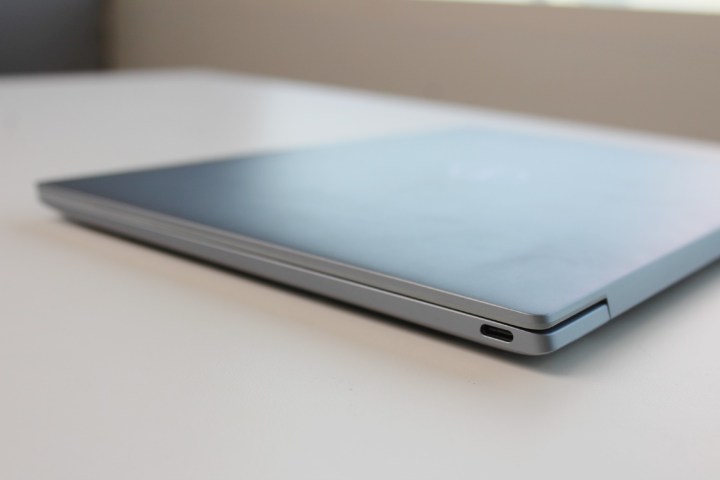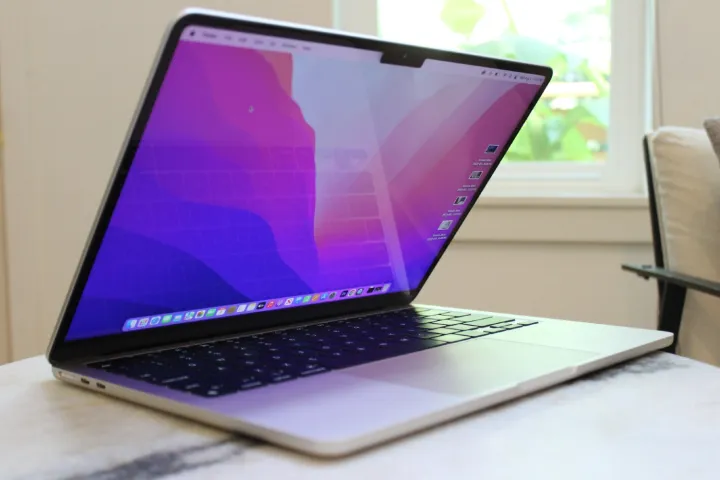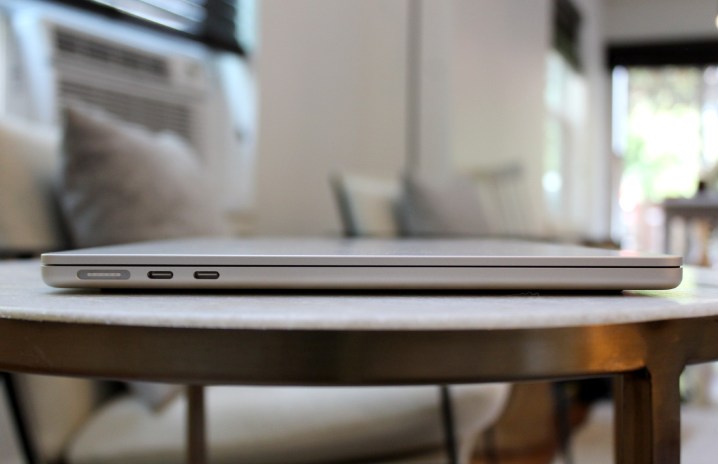Two of the best laptops you can buy, Dell’s XPS 13 and Apple’s MacBook Air, have undergone significant redesigns in their latest iterations. The XPS 13 9315 has transformed into an all-aluminum laptop with no carbon or glass fiber that’s thinner and lighter than ever while gaining Intel’s 12th-generation CPUs. The MacBook Air gains Apple’s latest CPU, the M2, while losing the iconic tapered design and becoming one of the thinnest laptops around.
Both laptops are small, incredibly well-built, and look great. And the XPS 13 has long been our favorite. Does the latest MacBook Air have what it takes to supplant it?
Specs
| Dell XPS 13 9315 | Apple MacBook Air M2 | |
| Dimensions | 11.63 inches by 7.86 inches by 0.55 inches | 11.97 inches by 8.46 inches by 0.44 inches |
| Weight | 2.59 pounds | 2.7 pounds |
| Processor | Intel Core i5-1230U Intel Core i7-1250U |
Apple M2 eight-core CPU, eight-Core GPU Apple Me eight-core CPU, 10-Core GPU |
| Graphics | Intel Iris Xe | Apple M2 |
| RAM | 8GB LPDDR5 16GB LPDDR5 32GB LPDDR5 |
8GB 16GB 24GB |
| Display | 13.4-inch 16:10 Full HD+ (1920 x 1080) IPS non-touch 13.4-inch 16:10 Full HD+ IPS touch |
13.5-inch 16:10 2360 x 1664 IPS |
| Storage | 512GB PCIe 4.0 solid-state drive (SSD) 1TB PCIe 4.0 SSD |
256GB PCIe SSD 512GB PCIe SSD 1TB PCIe SSD 2TB PCIe SSD |
| Touch | Optional | No |
| Ports | 2 USB-C with Thunderbolt 4 | 2 USB-C with Thunderbolt 4 3.5mm audio jack |
| Wireless | Wi-Fi 6E and Bluetooth 5.2 | Wi-Fi 6 and Bluetooth 5.0 |
| Webcam | 720p with Windows 11 Hello infrared camera | 1080p |
| Operating system | Windows 11 | macOS Monterey |
| Battery | 51 watt-hours | 52.6 watt-hours |
| Price | $999+ | $1,199+ |
| Rating | 4 out of 5 stars | 4 out of 5 stars |
Prices and configurations
The XPS 13 is an affordable premium laptop at its starting price of $999 for a Core i5-1230U CPU, 8GB of RAM, a 512GB SSD, and a non-touch display. It’s firmly in premium territory at $1,699, configured with a Core i7-1250U, 32GB of RAM, a 1TB SSD, and a touch display.
The MacBook Air M2 is more expensive, starting at $1,199 for an M2 processor with eight CPU cores/eight GPU cores, 8GB of RAM, and a 256GB SSD. It maxes out at a hefty $2,499 for an eight-core CPU/10-core GPU M2, 16GB of RAM, and a 2TB SSD.
Design

The XPS 13’s design was perfected over several years of iterations, resulting in a laptop we considered the best laptop you can buy. The new XPS 13 throws much of the old design philosophy away. The fiber keyboard deck is no more, with the laptop now sporting an even smaller all-aluminum chassis that greatly simplifies the aesthetic. The warmth that the fiber provided during use is gone as well. Two colors are available, Sky and Umber. Overall, it’s debatable whether the change is an improvement, but Dell clearly doesn’t want the XPS 13 to stagnate.
The MacBook Air M2 remains an all-aluminum affair, but it also loses its most iconic design element. It’s no longer tapered, appearing more in line with the MacBook Pro. It’s also incredibly thin at just 0.44 inches, making it one of the thinnest laptops ever made. It’s available in four colors: Space Gray, silver, Starlight, and Midnight. The MacBook Air M2 has smaller bezels, although not as small as the XPS 13’s, and it also has the notorious notch at the top that houses the webcam.

Both laptops are among the best-built options available. There’s no bending, flexing, or twisting anywhere in the lid or chassis.
The XPS 13 keyboard remains the same, making it among the best Windows 11 versions available today. It has a light touch with precise bottoming action, large keycaps, and plenty of key spacing. The touchpad is also fine, with a smooth surface and confident clicks to go with Microsoft Precision touchpad drivers and reliable Windows 11 multitouch gesture support. However, Apple’s Magic Keyboard is the best you can get on any laptop today, with even more precise switches and a bottoming action that’s springy and responsive. Its keycaps are perfectly sized with more than adequate key spacing, making it an incredibly comfortable keyboard for long typing sessions. And the MacBook Air M2’s Force Touch haptic touchpad is larger and more precise.
The MacBook Air M2 also benefits from a Full HD webcam versus the XPS 13’s 720p variety. It uses Apple’s Touch ID fingerprint reader for passwordless login, while the XPS 13 supports both a fingerprint reader and an infrared camera for facial recognition.
Connectivity is almost evenly matched, with both laptops sporting two USB-C ports with Thunderbolt 4 support. The most significant difference is that the MacBook Air M2 maintains a 3.5mm audio jack while the XPS 13, unfortunately, omits it. That’s a disappointment and gives Apple a leg up. The XPS 13 does have more up-to-date wireless connectivity with Wi-Fi 6E and Bluetooth 5.2 versus Wi-Fi 6 and Bluetooth 5.0.
Performance

The XPS 13 utilizes Intel 12th-gen CPUs, specifically the Core i5-1230U and Core i7-1250U. Both are 9-watt, 10-core (two Performance and eight Efficient), 12-thread processors, with the Core i5 running at a max Turbo frequency of 4.40GHz and the Core i7 ramping up to 4.70GHz. The clocks are lower than last-gen, but the improved architecture and additional cores of Alder Lake should give them a good performance boost, as well as enhance efficiency.
The MacBook Air M2 utilizes Apple’s eight-core CPU with up to a 10-core GPU M2, which the company claims is up to 18% faster than the M1 in CPU processes and with a GPU that’s as much as 35% faster. The MacBook Air M1 was already faster than the previous-generation XPS 13, and with the latter’s drop to a low-power Intel CPU, the MacBook Air M2 is even faster yet.
There’s no doubt that the MacBook Air M2 dominates when it comes to performance versus the new XPS 13. And we should note that the MacBook Air M2 is fanless, meaning it will be completely silent even when operating under heavy loads. The XPS 13 can’t boast the same claim.
| Dell XPS 13 9315 (Core i5-1230U) |
Apple MacBook Air M2 (Apple M2) |
|
| Geekbench 5 (single / multi) |
Bal: 1,393/ 4,459 Perf: 1,477 / 5,350 |
Bal: 1,925 / 8,973 Perf: N/A |
| Handbrake (seconds) |
Bal: 333 Perf: 192 |
Bal: 151 Perf: N/A |
| Cinebench R23 (single / multi) |
Bal: 1,379 / 3,457 Perf: N/A |
Bal: 1,600 / 7,938 Perf: N/A |
Display

The XPS 13 comes with a choice of touch and non-touch 13.4-inch 16:10 Full HD+ (1920 x 1200) IPS displays. There’s no longer an OLED panel option, which is available on the more expensive XPS 13 Plus.
The MacBook Air M2 has a new and improved 13.6-inch 16:10 Liquid Retina IPS display at 2560 x 1664, with wider and more accurate colors and higher contrast. It’s superior to the XPS 13’s in quality while also being considerably sharper.
| Dell XPS 13 9315 (IPS) |
Apple MacBook Air M2 (IPS) |
|
| Brightness (nits) |
444 | 486 |
| AdobeRGB gamut | 75% | 90% |
| sRGB gamut | 99% | 100% |
| Accuracy (DeltaE, lower is better) |
1.33 | 1.08 |
| Contrast ratio | 1,390:1 | 1,310:1 |
Portability

The XPS 13 is slightly narrower than the MacBook Air M2 and more than half an inch shallower. It also weighs less at 2.59 pounds versus 2.7 pounds, but it’s not as thin, measuring 0.55 inches versus 0.44 inches. Both laptops are tiny enough to toss in a backpack and forget they’re there, though, so the difference doesn’t isn’t big enough to be a major selling point for either.
In terms of battery life, though, the MacBook Air M2 is far superior. The XPS 13 does well for a Windows laptop at 13.25 hours in our web browsing test, but the MacBook lasts almost 18 hours in the same test. It also came in at 21 hours of watching a local video. That’s spectacular battery life that few Windows laptops can match. The XPS 13 doesn’t even get close.
| Dell XPS 13 9315 (Core i5-1230U) |
Apple MacBook Air M2 (Apple M2) |
|
| Web browsing | 13 hours, 18 minutes | 17 hours, 59 minutes |
| Video | N/A | 21 hours, 9 minutes |
The MacBook Air M2 wins this, but at a cost
The MacBook Air M2 is faster and thinner, has significantly better battery life, and sports a better keyboard and touchpad. It’s a better laptop than Dell’s latest XPS 13. If you’re on a budget, though, or prefer Windows 11, then the XPS 13 is still a great choice.



